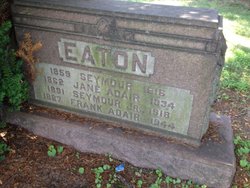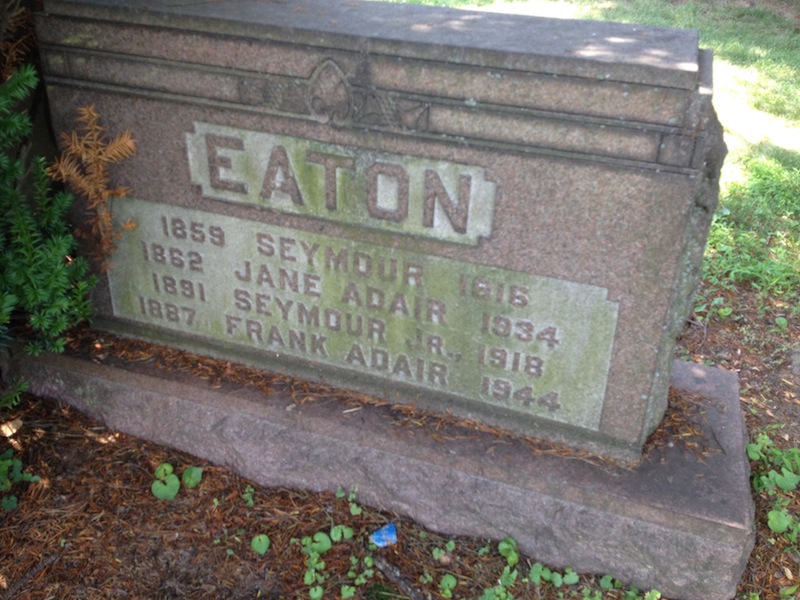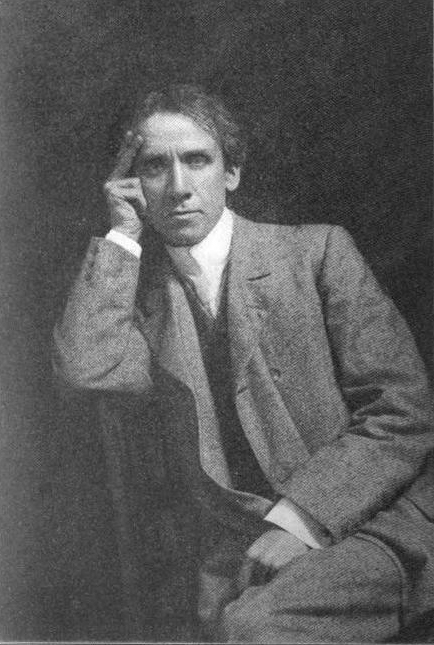From the Printer's Ink, Vol 47, no. 8, May 25, 1904
Seymour Eaton was born in Canada in 1859, and after a college course began writing on business subjects. A book entitled "Business Forms" was one of his first productions, and another volume on "How to Do Business" has attained a national circulation. Then he wrote a series of school textbooks and became a publisher in this field in Boston. Most of these text-books are in use to-day. From that grew a series of volumes called the "Home Study Library," and from these he gained a reputation that led to a call to Drexel Institute, Philadelphia, as director of the School of Commerce and Finance. That was in 1883. In 1896 he evolved the plan of the Chicago Record's home study courses, which he directed for four years. These courses were syndicated in leading dailies throughout the United States, and the salary paid their director was in the nature of a revelation to the educational world.
The Booklovers' Library was the outgrowth of an idea that Mr. Eaton had carried about several years. When the plan was put into operation in 1900 it was liberally advertised in advance, and when the first libraries were opened in New York, Philadelphia and Boston there was a rush of patrons beyond what had been provided for. The Tabard Inn Library, organized in 1902, was largely an outgrowth of the unexpected progress made by the Booklovers' Library.
From ZoomInfo.com
The Booklovers Library's founder Seymour Eaton claimed that the library was, "The Largest Circulating Library in the World." Eaton who was a promoter of the first order also described the library as "The most (sic) unique library system in the World" and as "The most attractive book service in the world."
The first Booklovers Library was opened in Philadelphia on March 5,1900. By December 1, 1901, Eaton claimed that there were fifty branch libraries in major cities across the country and that book deliveries were being "made in practically every city and town of 1,000 population or over in the United States." The Booklovers Library was a membership library and a stock corporation and Eaton marketed both aspects with great effectiveness.
Eaton also established the Tabard Inn Library which was targeted at a broader audience. He developed and promoted a variety of spin off enterprises related to the Booklovers and Tabard Inn libraries.
The Tabard Inn Library was a membership library with stations in the form of revolving bookcases located in drug stores and other commercial establishments throughout the United States. In an initial advertisement for the library, Eaton indicated that 10,000 of these bookcases would be manufactured at a rate of 25 and then 50 a day.
Eaton used this procedure to develop a mailing list containing the names of a million men and women. He used the list to promote other ventures including the Tabard Inn Food Company.
(Eaton developed a line of druggist sundries which he marketed through this company including a "JAPANESE DENTAL STONE" packaged in a milk glass container with an instruction label on the underside. - BZS)
Unfortunately, the revenue generated by these collective enterprises wasn't sufficient to sustain them and in March 1905 he declared bankruptcy.
From the Printer's Ink, Vol 71, no. , April 20, 1910
EGGS FROM HEN TO CONSUMER VIA ADVERTISING.
SEYMOUR EATON PROMOTING "16HOUR EGG" PROJECT THROUGHNEWSPAPER ADVERTISING, WITH PLENTIFUL RESULTS—AGENCY DISTRIBUTION PLANNED.
"16-Hour Eggs. The best fresh egg service in New York. Price 40 cents per dozen. At all grocers." There is a story of far-reaching advertising sense behind this announcement which is appearing in the New York papers nowadays. The man behind this new venture, which was initiated with the first of March, is Seymour Eaton, of Tabard Inn fame, and now allied with the Jamaica Estates and Garden City Estates ventures. Mr. Eaton's 16-Hour Egg advertising is interesting, in that back of it lies an unusual attempt to force distribution.
The scheme is such a simple one that the wonder is that it has not been thought of before. Mr. Eaton has a son, Stafford, who, upon graduation recently, expressed the desire to go into the chicken-raising business, to which his father acquiesced. Young Eaton started out to learn the business, and became associated with a model chicken farm in Pennsylvania. His week-end reports to his sire of the primitive way in which the eggs from the farm were marketed, being sent to the cities hopelessly intermingled with ordinary barnyard eggs of inferior quality, convinced the latter that far the more pleasing and profitable business for him would be the proper marketing of the model eggs. The name "16Hour" was taken because it told the whole story, and because it was feared a higher figure, such as "18-Hour" or "24-Hour" might be cut under by some ambitious competitor at a latter date. Sixteen is looked upon as the fewest possible number of hours in which to market eggs. The scheme is to fairly snatch the eggs out from under the hens at the Pennsylvania farm at 4 o'clock one afternoon; wrap, date, and sell them, and ship them by express, on a fast train, starting at 6.35, so that they can reach New York and be delivered to the grocers before 8 o'clock the next morning, or sixteen hours later.
American educator Seymour Eaton wrote the children's book series The Roosevelt Bears. (Wikipedia)
From Fred Patten http://www.flayrah.com/4178/retrospective-seymour-eatons-roosevelt-bears
From 1905 for about the next twenty years, Seymour Eaton's anthropomorphic bears were the subject of some of the most popular children's books in America. Their topical popularity was due to the tie-in between the bears and Teddy Roosevelt during the 1900s when TR was President of the U.S., and the 1910s when there was widespread speculation whether he would try to run for a third term.
But Eaton died in 1916 and Roosevelt died just two months after World War I ended. The publisher tried to keep the series alive with reprints in 1921, but by the Roaring ‘20s American pop culture had moved on, and TR and the Roosevelt Bears became quickly passé.
(Except to the millions who bought and loved Teddy Bears thereafter and the thousands who collect Teddy Bears today - BZS)
From the Printer's Ink, Vol 47, no. 8, May 25, 1904
Seymour Eaton was born in Canada in 1859, and after a college course began writing on business subjects. A book entitled "Business Forms" was one of his first productions, and another volume on "How to Do Business" has attained a national circulation. Then he wrote a series of school textbooks and became a publisher in this field in Boston. Most of these text-books are in use to-day. From that grew a series of volumes called the "Home Study Library," and from these he gained a reputation that led to a call to Drexel Institute, Philadelphia, as director of the School of Commerce and Finance. That was in 1883. In 1896 he evolved the plan of the Chicago Record's home study courses, which he directed for four years. These courses were syndicated in leading dailies throughout the United States, and the salary paid their director was in the nature of a revelation to the educational world.
The Booklovers' Library was the outgrowth of an idea that Mr. Eaton had carried about several years. When the plan was put into operation in 1900 it was liberally advertised in advance, and when the first libraries were opened in New York, Philadelphia and Boston there was a rush of patrons beyond what had been provided for. The Tabard Inn Library, organized in 1902, was largely an outgrowth of the unexpected progress made by the Booklovers' Library.
From ZoomInfo.com
The Booklovers Library's founder Seymour Eaton claimed that the library was, "The Largest Circulating Library in the World." Eaton who was a promoter of the first order also described the library as "The most (sic) unique library system in the World" and as "The most attractive book service in the world."
The first Booklovers Library was opened in Philadelphia on March 5,1900. By December 1, 1901, Eaton claimed that there were fifty branch libraries in major cities across the country and that book deliveries were being "made in practically every city and town of 1,000 population or over in the United States." The Booklovers Library was a membership library and a stock corporation and Eaton marketed both aspects with great effectiveness.
Eaton also established the Tabard Inn Library which was targeted at a broader audience. He developed and promoted a variety of spin off enterprises related to the Booklovers and Tabard Inn libraries.
The Tabard Inn Library was a membership library with stations in the form of revolving bookcases located in drug stores and other commercial establishments throughout the United States. In an initial advertisement for the library, Eaton indicated that 10,000 of these bookcases would be manufactured at a rate of 25 and then 50 a day.
Eaton used this procedure to develop a mailing list containing the names of a million men and women. He used the list to promote other ventures including the Tabard Inn Food Company.
(Eaton developed a line of druggist sundries which he marketed through this company including a "JAPANESE DENTAL STONE" packaged in a milk glass container with an instruction label on the underside. - BZS)
Unfortunately, the revenue generated by these collective enterprises wasn't sufficient to sustain them and in March 1905 he declared bankruptcy.
From the Printer's Ink, Vol 71, no. , April 20, 1910
EGGS FROM HEN TO CONSUMER VIA ADVERTISING.
SEYMOUR EATON PROMOTING "16HOUR EGG" PROJECT THROUGHNEWSPAPER ADVERTISING, WITH PLENTIFUL RESULTS—AGENCY DISTRIBUTION PLANNED.
"16-Hour Eggs. The best fresh egg service in New York. Price 40 cents per dozen. At all grocers." There is a story of far-reaching advertising sense behind this announcement which is appearing in the New York papers nowadays. The man behind this new venture, which was initiated with the first of March, is Seymour Eaton, of Tabard Inn fame, and now allied with the Jamaica Estates and Garden City Estates ventures. Mr. Eaton's 16-Hour Egg advertising is interesting, in that back of it lies an unusual attempt to force distribution.
The scheme is such a simple one that the wonder is that it has not been thought of before. Mr. Eaton has a son, Stafford, who, upon graduation recently, expressed the desire to go into the chicken-raising business, to which his father acquiesced. Young Eaton started out to learn the business, and became associated with a model chicken farm in Pennsylvania. His week-end reports to his sire of the primitive way in which the eggs from the farm were marketed, being sent to the cities hopelessly intermingled with ordinary barnyard eggs of inferior quality, convinced the latter that far the more pleasing and profitable business for him would be the proper marketing of the model eggs. The name "16Hour" was taken because it told the whole story, and because it was feared a higher figure, such as "18-Hour" or "24-Hour" might be cut under by some ambitious competitor at a latter date. Sixteen is looked upon as the fewest possible number of hours in which to market eggs. The scheme is to fairly snatch the eggs out from under the hens at the Pennsylvania farm at 4 o'clock one afternoon; wrap, date, and sell them, and ship them by express, on a fast train, starting at 6.35, so that they can reach New York and be delivered to the grocers before 8 o'clock the next morning, or sixteen hours later.
American educator Seymour Eaton wrote the children's book series The Roosevelt Bears. (Wikipedia)
From Fred Patten http://www.flayrah.com/4178/retrospective-seymour-eatons-roosevelt-bears
From 1905 for about the next twenty years, Seymour Eaton's anthropomorphic bears were the subject of some of the most popular children's books in America. Their topical popularity was due to the tie-in between the bears and Teddy Roosevelt during the 1900s when TR was President of the U.S., and the 1910s when there was widespread speculation whether he would try to run for a third term.
But Eaton died in 1916 and Roosevelt died just two months after World War I ended. The publisher tried to keep the series alive with reprints in 1921, but by the Roaring ‘20s American pop culture had moved on, and TR and the Roosevelt Bears became quickly passé.
(Except to the millions who bought and loved Teddy Bears thereafter and the thousands who collect Teddy Bears today - BZS)







